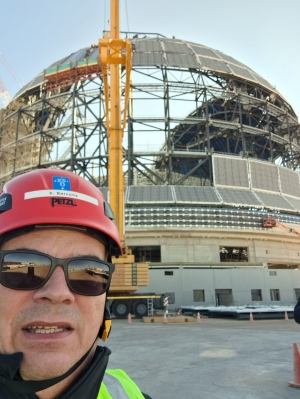Dear colleagues,
From several viewpoints, 2024 was a year when ESO started to move towards new future avenues, while running very strong on its current commitments.

Dear colleagues,
From several viewpoints, 2024 was a year when ESO started to move towards new future avenues, while running very strong on its current commitments.
ESO continued enabling many scientific achievements and breakthroughs. Among those, the discovery of the most massive and fastest accreting black hole, a detailed image of an aging star in the Large Magellanic Cloud showing drastic ejecta, a rotating disk galaxy at very high redshift (z=7.31) or the relationship of water and planetary formation in the iconic HL Tau young star. Not yet published is the direct measurement of the Super Massive Black Hole mass of a QSO at z=4 through the kinematics of its Broad Line Region. At the time of writing (15 December 2024) the number of refereed publications enabled by ESO in 2024 exceeds 850, so it is likely that the 1000 reference figure will be reached or exceeded.
Progress was excellent in all fronts of ELT construction, although not exempt of difficulties. Beyond the formal completion of the 60%, the “beginning of the end” of the long phase until the project is complete became visible. ESO starts to receive the full manufactured items from our contractors (e.g., M5 cell, Lasers, Edge Sensors so far) that will be integrated into the telescope; more to come.
Progress was particularly visible in the Dome and Main Structure (the mechanical structure of the ELT telescope is erected in Armazones now). In optomechanics, 150 M1 segment assemblies (polished and coated) are in Paranal’s ELT Technical Facility, waiting to go to the telescope; M2 was polished to its final specs (40 nm!!!), with M3 following, and the M5 SiC blank is now at the polisher’s premises.
Two instruments, METIS and MICADO, successfully passed FDR, with MORFEO to follow. HARMONI is undergoing a redefinition of its scope and the consortium is also undergoing changes. ANDES passed system architectural review and is moving forward, with MOSAIC to follow next year.
The ELT will be the first of the ELTs on sky by a large margin, delivering science before the end of the decade. The “low-hanging-fruit” effect that is known to happen when the first of a new generation of telescopes comes on-line, will be for the ESO community to exploit. ESO and the community we serve will need to prepare for this scientific exploitation phase in the coming years.
The La Silla Paranal Observatory continued efficient operation, with nominal data delivery; this has become part of the routine, although it takes a gigantic effort. The Data Flow System, which ESO pioneered 3 decades ago in preparation for the VLT observations, is being updated to accommodate the requirements from the ELT. GRAVITY+ completed the installation of the new adaptive optics system GPAO, thanks to a big effort from the consortium and ESO personnel from both Paranal and Garching. Installation of 4MOST and MOONS slipped into 2025. SoXS will be shipped to La Silla in early 2025.
ALMA achieved almost the reference target of 4300 hours of observing time with the 12 m array in Cycle 10. Better planning of technical activities and improved scheduling were key to this achievement. The Wide-Band Sensitivity Upgrade (WSU) is taking shape as a “programme”, a coherent collection of projects. The understanding of the WSU scope and priorities needs to be finalized in 2025. In ESO's view, getting the infrastructure and the "telescope" system has higher priority than developing new receiver bands, which may come later. In this difficult environment, ESO is working to secure a long-term competitive ALMA observatory within the existing financial boundaries.
CTA went through a very difficult year, due to legal challenges to establishing the CTAO ERIC. New CTAO ERIC statutes were submitted to the European Commission with informal positive feedback so far. In parallel, CTAO has been recruiting a number of key people necessary for the project construction. CTA-South infrastructure (roads, foundations, connection to the power grid etc) is at the stage of evaluating bids from companies and expected to start in 2025.
In a landmark strategic decision, Council approved in June 2024 the process – called Expanding Horizons - to select its next (post-ELT) Programme. This is a very powerful signal to the community, our Member States and the entire world: ESO is looking forward to defining its long-term future. Not only will ESO offer to its communities the first and most powerful of the ELTs, putting Europe for the first time in history at the forefront of ground-based astronomy, but the intent is to retain that position.
To achieve this, a strong and efficient organization is needed. Maintaining the capacity to build and operate large and complex facilities remains one of ESO's assets, building over the last decades. This requires strong professional support services, which are not always seen from the outside, but which ESO needs to scale appropriately to the size and complexity of its programmes. Internal effort is being deployed to develop a new observatory operations model (of the VLT, VLTI and ELT, maybe also CTA-South) through the Integrated Operations Programme (IOP). The first and most urgent IOP project, the maintenance process of the ELT Dome and Main Structure, is progressing. On a similar front, a new ERP (Enterprise Resource Planning) tool will start its deployment in 2025 to make the organization's processes more efficient. Managing complexity is one of the challenges that a multi-programme organization like ESO faces.
In closing this exciting 2024, I would like to thank the entire scientific community for the unfailing support to ESO and the trust in the organization.
Xavier Barcons
ESO Director General